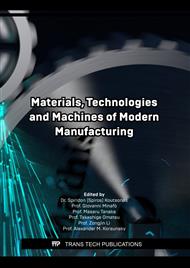[1]
Degerliyurt K, Simsek B, Erkmen E, et al. Effects of different fixture geometries on the stress distribution in mandibular peri-implant structures: a 3-dimensional finite element analysis. Oral Surgery Oral Medicine Oral Pathology Oral Radiology & Endodontology.110 (2010) e1-e11.
DOI: 10.1016/j.tripleo.2010.03.029
Google Scholar
[2]
Kim D G, Jeong Y H, Chien H H. Immediate mechanical stability of threaded and porous implant systems. Clinical Biomechanics. 48 (2017) 110-117.
DOI: 10.1016/j.clinbiomech.2017.08.001
Google Scholar
[3]
Lee C C, Lin S C, Kang M J. Effects of implant threads on the contact area and stress distribution of marginal bone. Journal of Dental Sciences. (5) 2010 156-165.
DOI: 10.1016/s1991-7902(10)60023-2
Google Scholar
[4]
Steigenga JT, al-Shammari KF, Nociti FH, Misch CE, Wang HL. Dental implant design and its relationship to long-term implant success. Implant Dentistry (12) 2003 306-317.
DOI: 10.1097/01.id.0000091140.76130.a1
Google Scholar
[5]
Freitas-Júnior, Amilcar, C., Rocha, E.P., Bonfante, E.A., Almeida, E.O., Anchieta, R. B., Martini, A.P. Biomechanical evaluation of internal and external hexagon platform switched implant-abutment connections: An in vitro laboratory and three-dimensional finite element analysis. Dental Material. (28) 2012 e218-228.
DOI: 10.1016/j.dental.2012.05.004
Google Scholar
[6]
Bobyn J D, Stackpool G J, Hacking S A. Characteristics of bone ingrowth and interface mechanics of a new porous tantalum biomaterial. The Bone & Joint Journal. (81) 1999 907-914.
DOI: 10.1302/0301-620x.81b5.0810907
Google Scholar
[7]
Edelmann A R, Patel D, Allen R K. Retrospective analysis of porous tantalum trabecular metal-enhanced titanium dental implants. The Journal of Prosthetic Dentistry. (121) 2019 404-410.
DOI: 10.1016/j.prosdent.2018.04.022
Google Scholar
[8]
Bencharit S, Byrd W C, Altarawneh S. Development and Applications of Porous Tantalum Trabecular Metal-Enhanced Titanium Dental Implants. Clinical Implant Dentistry and Related Research. (16) 2014 817-826.
DOI: 10.1111/cid.12059
Google Scholar
[9]
Vaillancourt, H., Pilliar, R.M., Mccammond, D. Factors Affecting Crestal Bone Loss With Dental Implants Partially Covered With a Porous Coating: A Finite Element Analysis. International Journal of Oral & Maxillofacial Implants. (11) 1996 351-359.
DOI: 10.1002/jab.770060408
Google Scholar
[10]
Sato, Y., Wadamoto, M., Tsuga, K., Teixeira, E.R., 1999.The effectiveness of elemant downsizlng on a three-dimensional finite element model of bone trabeculae in implant biomechanies. Journal of Oral Rehabilitation. (26) 1999 288–291.
DOI: 10.1046/j.1365-2842.1999.00390.x
Google Scholar
[11]
Han W, Kexin S, Leizheng S. The effect of 3D-printed Ti6Al4V scaffolds with various macropore structures on osteointegration and osteogenesis: A biomechanical evaluation. Journal of the Mechanical Behavior of Biomedical Materials. (88) 2018 488-496.
DOI: 10.1016/j.jmbbm.2018.08.049
Google Scholar
[12]
Hajimiragha H, Abolbashari M, Nokar S. Bone Response From a Dynamic Stimulus on a One-Piece and Multi-Piece Implant Abutment and Crown by Finite Element Analysis. Journal of Oral Implantology. (40) 2014 525-532.
DOI: 10.1563/aaid-joi-d-10-00170
Google Scholar
[13]
Brosh T, Pilo R, Sudai D. The influence of abutment angulation on strains and stresses along the implant/bone interface: comparison between two experimental techniques. J Prosthet Dent. (79) 1998 328–334.
DOI: 10.1016/s0022-3913(98)70246-x
Google Scholar
[14]
Ha S.R, Kim S.H, Lee J.B. Effects of coping designs on stress distributions in zirconia crowns: Finite element analysis. Ceramics International. (42) 2016 4932-4940.
DOI: 10.1016/j.ceramint.2015.12.007
Google Scholar
[15]
Da, S.N.J.P., Jardim, P.M., Neves Flávio Domingues das, Xediek, C.R.L., Dos, S.M.B.F. Stress analysis of different configurations of 3 implants to support a fixed prosthesis in an edentulous jaw. Braz Oral Res. (28) 2014 67-73.
DOI: 10.1590/s1806-83242013005000028
Google Scholar
[16]
Dong, W., Kebin, T., Jiang, C., Hua, J., Wenxiu, H., Yuyu, L. A further finite element stress analysis of angled abutments for an implant placed in the anterior maxilla. Computational and Mathematical Methods in Medicine. (2015) 2015 1-9.
DOI: 10.1155/2015/560645
Google Scholar
[17]
Chun H J, Cheong S Y, Han J H, Heo S J. Evaluation of design parameters of osseointegrated dental implants using finite element analysis. Journal of Oral Rehabilitation. (29) 2002 565-574.
DOI: 10.1046/j.1365-2842.2002.00891.x
Google Scholar
[18]
Holmgren E P, Seckinger R J, Kilgren L M, Mante F. Evaluating parameters of osseointegrated dental implants using finite element analysis—a two-dimensional comparative study examining the effects of implant diameter, implant shape, and load direction. J. Oral Implantol. (24) 1998 80-88.
DOI: 10.1563/1548-1336(1998)024<0080:epoodi>2.3.co;2
Google Scholar
[19]
Bordin D, Bergamo E T P, Fardin V P. Fracture strength and probability of survival of narrow and extra-narrow dental implants after fatigue testing:,In vitro, and, in silico, analysis. Journal of the Mechanical Behavior of Biomedical Materials. (71) 2017 244-249.
DOI: 10.1016/j.jmbbm.2017.03.022
Google Scholar
[20]
Freitas-Júnior, Amilcar C, Rocha E P, Bonfante E A. Biomechanical evaluation of internal and external hexagon platform switched implant-abutment connections: An in vitro laboratory and three-dimensional finite element analysis. Dental Materials. (28) 2012 218-228.
DOI: 10.1016/j.dental.2012.05.004
Google Scholar



